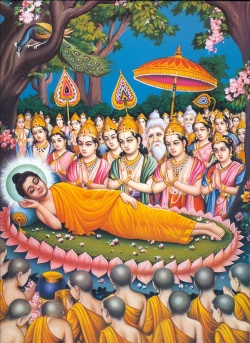Anāgāmi
In Buddhism, an anāgāmi (Sanskrit and Pāli for "non-returning") is a partially enlightened person who has cut off the first five chains that bind the ordinary mind. Anagami-ship is the third of the four stages of enlightenment.
Anagamis are not reborn into the human world after death, but into the heaven of the Pure Abodes, where only anagamis live. There they attain full enlightenment (arahantship).
The Pali terms for the specific chains or fetters (Pali: saṃyojana) of which an anagami is free are:
- Sakkāya-diṭṭhi: Belief in self
- Vicikicchā: Skeptical doubt
- Sīlabbata-parāmāsa: Attachment to rites and rituals
- Kāma-rāga: Sensuous craving
- Byāpāda: Ill will
The fetters from which an anagami is not yet free are:
- Rūpa-rāga: Craving for fine-material existence (the first 4 jhanas)
- Arūpa-rāga: Craving for immaterial existence (the last 4 jhanas)
- Māna: Conceit
- Uddhacca: Restlessness
- Avijjā: Ignorance
Anagamis are at an intermediate stage between sakadagamis and arahants. Arahants enjoy complete freedom from the ten fetters.
Attaining the state of non-returner is portrayed in the early texts as the ideal goal for laity.
